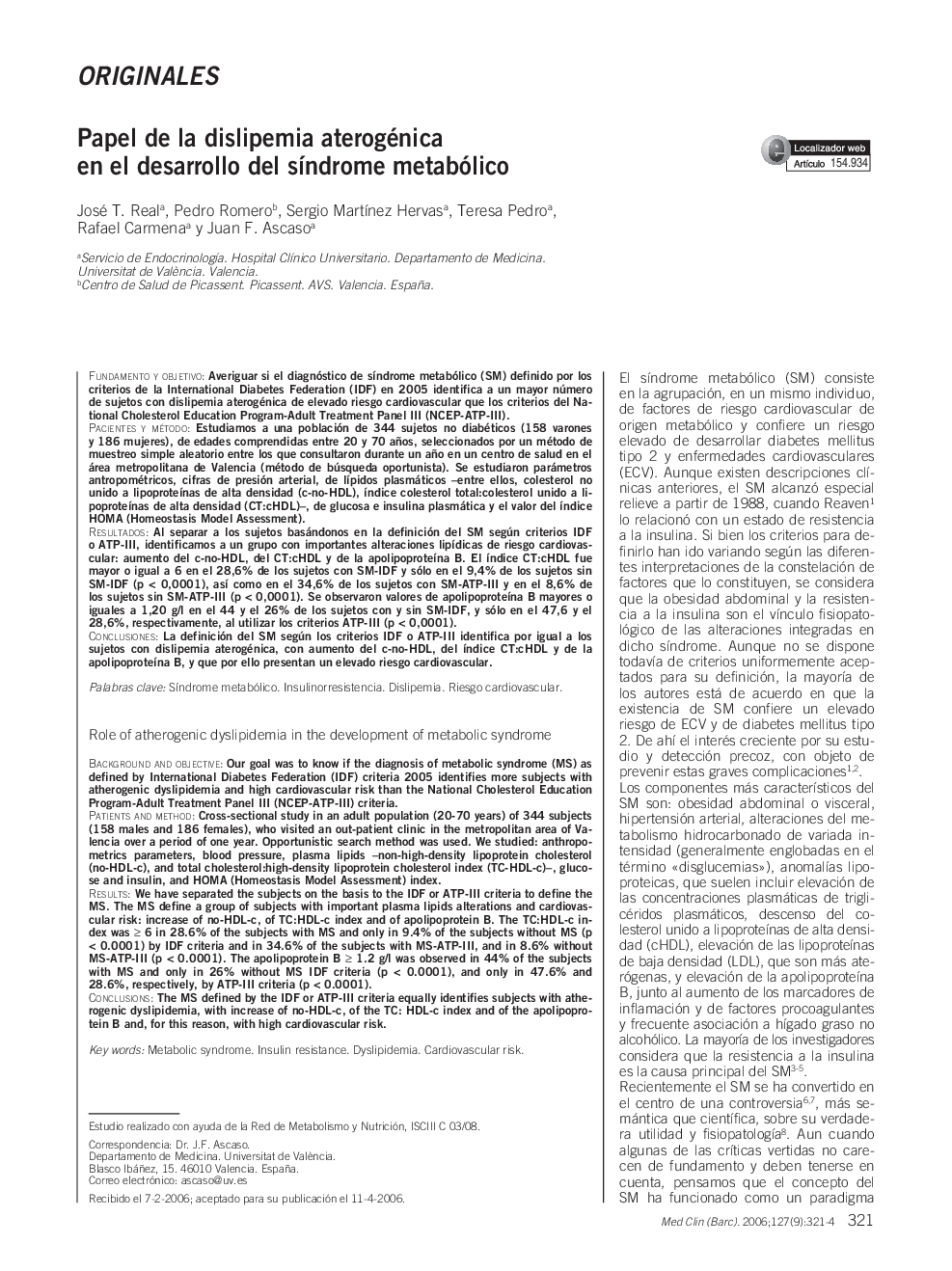| کد مقاله | کد نشریه | سال انتشار | مقاله انگلیسی | نسخه تمام متن |
|---|---|---|---|---|
| 3800237 | 1244624 | 2006 | 4 صفحه PDF | دانلود رایگان |

Fundamento y objetivoAveriguar si el diagnóstico de sÃndrome metabólico (SM) definido por los criterios de la International Diabetes Federation (IDF) en 2005 identifica a un mayor número de sujetos con dislipemia aterogénica de elevado riesgo cardiovascular que los criterios del National Cholesterol Education Program-Adult Treatment Panel III (NCEP-ATP-III).Pacientes y métodoEstudiamos a una población de 344 sujetos no diabéticos (158 varones y 186 mujeres), de edades comprendidas entre 20 y 70 años, seleccionados por un método de muestreo simple aleatorio entre los que consultaron durante un año en un centro de salud en el área metropolitana de Valencia (método de búsqueda oportunista). Se estudiaron parámetros antropométricos, cifras de presión arterial, de lÃpidos plasmáticos -entre ellos, colesterol no unido a lipoproteÃnas de alta densidad (c-no-HDL), Ãndice colesterol total:colesterol unido a lipoproteÃnas de alta densidad (CT:cHDL)-, de glucosa e insulina plasmática y el valor del Ãndice HOMA (Homeostasis Model Assessment).ResultadosAl separar a los sujetos basándonos en la definición del SM según criterios IDF o ATP-III, identificamos a un grupo con importantes alteraciones lipÃdicas de riesgo cardiovascular: aumento del c-no-HDL, del CT:cHDL y de la apolipoproteÃna B. El Ãndice CT:cHDL fue mayor o igual a 6 en el 28,6% de los sujetos con SM-IDF y sólo en el 9,4% de los sujetos sin SM-IDF (p < 0,0001), asà como en el 34,6% de los sujetos con SM-ATP-III y en el 8,6% de los sujetos sin SM-ATP-III (p < 0,0001). Se observaron valores de apolipoproteÃna B mayores o iguales a 1,20 g/l en el 44 y el 26% de los sujetos con y sin SM-IDF, y sólo en el 47,6 y el 28,6%, respectivamente, al utilizar los criterios ATP-III (p < 0,0001).ConclusionesLa definición del SM según los criterios IDF o ATP-III identifica por igual a los sujetos con dislipemia aterogénica, con aumento del c-no-HDL, del Ãndice CT:cHDL y de la apolipoproteÃna B, y que por ello presentan un elevado riesgo cardiovascular.
Background and objectiveOur goal was to know if the diagnosis of metabolic syndrome (MS) as defined by International Diabetes Federation (IDF) criteria 2005 identifies more subjects with atherogenic dyslipidemia and high cardiovascular risk than the National Cholesterol Education Program-Adult Treatment Panel III (NCEP-ATP-III) criteria.Patients and methodCross-sectional study in an adult population (20-70 years) of 344 subjects (158 males and 186 females), who visited an out-patient clinic in the metropolitan area of Valencia over a period of one year. Opportunistic search method was used. We studied: anthropometrics parameters, blood pressure, plasma lipids -non-high-density lipoprotein cholesterol (no-HDL-c), and total cholesterol: high-density lipoprotein cholesterol index (TC-HDL-c)-, glucose and insulin, and HOMA (Homeostasis Model Assessment) index.ResultsWe have separated the subjects on the basis to the IDF or ATP-III criteria to define the MS. The MS define a group of subjects with important plasma lipids alterations and cardiovascular risk: increase of no-HDL-c, of TC:HDL-c index and of apolipoprotein B. The TC:HDL-c index was ⥠6 in 28.6% of the subjects with MS and only in 9.4% of the subjects without MS (p < 0.0001) by IDF criteria and in 34.6% of the subjects with MS-ATP-III, and in 8.6% without MS-ATP-III (p < 0.0001). The apolipoprotein B â¥Â 1.2 g/l was observed in 44% of the subjects with MS and only in 26% without MS IDF criteria (p < 0.0001), and only in 47.6% and 28.6%, respectively, by ATP-III criteria (p < 0.0001).ConclusionsThe MS defined by the IDF or ATP-III criteria equally identifies subjects with atherogenic dyslipidemia, with increase of no-HDL-c, of the TC: HDL-c index and of the apolipoprotein B and, for this reason, with high cardiovascular risk.
Journal: Medicina ClÃnica - Volume 127, Issue 9, September 2006, Pages 321-324